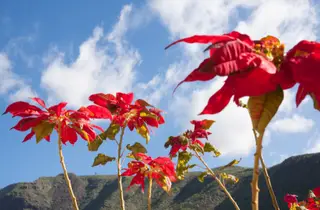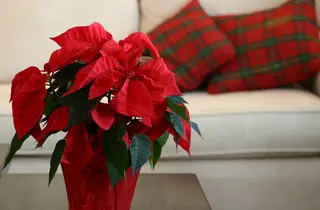Poinsettia plants are one of the most recognizable and beautiful decorative features of the holiday season. Yet once the holidays pass, many people give up on keeping their poinsettia alive and are quick to discard this popular holiday plant.
But did you know that there are ways to make your poinsettia plants last longer than ever before? It’s even possible to keep them alive long enough to bloom again during next year’s Christmas season.
If you love poinsettias and want to keep yours around longer than most people do, then you are in luck. In this article, we’ll share some of the most effective tips for keeping your poinsettia alive longer.
![How to Keep Your Poinsettia Alive Longer [7 Tips]](https://wraxly.com/wp-content/uploads/2022/05/How-to-Keep-Your-Poinsettia-Alive-Longer-7-Tips.webp)
- 1) Keep Your Poinsettia Alive by Keeping it Warm
- 2) Give the Soil a Chance to Drain
- 3) Let Your Poinsettias Have the Right Amount of Light
- 4) Feed Your Poinsettias Often
- 5) Repot Your Poinsettia
- 6) Take Your Poinsettia Outdoors During the Summer Months
- 7) Grow Only the Healthiest Poinsettia Plants
- FAQ's About Keeping a Poinsettia Alive
- Final Thoughts on Keeping a Poinsettia Alive
1) Keep Your Poinsettia Alive by Keeping it Warm
Poinsettias enjoy areas that have warm air temperatures. These tropical plants come from hotter regions of the world, like Mexico and other Central American countries, and require an air temperature that falls in the range of 65 to 75 degrees Fahrenheit or above.
When your poinsettias are indoors, ensure that they sit in a place that always remains warm. Beware of any cold drafts, cold windows, or any other factors that could cause the temperature to drop. Exposure to air that is too cool will harm your poinsettias and cause them to decline more quickly.
2) Give the Soil a Chance to Drain
Poinsettias won’t survive long if they don’t have adequate drainage. Like many plants, poinsettias enjoy having plenty of soil moisture but do not tolerate any standing water. If the soil inside your container is too heavy, it will likely hold more water than your poinsettia prefers. Choose to use a potting mix that is relatively loose but able to hold enough moisture for the plant to survive.
The container in which your poinsettia lives should have large drainage holes at the bottom of the pot or some other method of allowing excess water to drain quickly. At times, your poinsettia may come in a container that includes holiday wrapping on the outside. It’s wise to remove this wrapping as it can interfere with drainage, despite how pretty it may look.

3) Let Your Poinsettias Have the Right Amount of Light
If you want to keep your poinsettia alive longer, you need to give them the ideal amount of light each day. During the day, your plant will grow best if it receives plenty of bright, indirect light. A sunny spot near a window is often best for producing these conditions.
Interestingly, poinsettias need plenty of darkness as well before and during the blooming period. Without complete darkness for about 13 to 14 hours per day, your poinsettia will fail to bloom. Giving your poinsettia bright light during the day and uninterrupted darkness at night is a perfect way to encourage the ideal blooming characteristics and longevity.
4) Feed Your Poinsettias Often
Fertilization will help your poinsettias exhibit more vigorous growth and keep your poinsettia alive longer overall. There are many types of fertilizer you can use for a poinsettia, but a general-purpose mix that has equal amounts of nitrogen, phosphorus, and potassium will work well to encourage a more robust and long-lasting plant. See: Tomato Tone vs. Garden Tone: Which One Is Better?
If you aim to keep your poinsettias alive all year long, you can give them fertilizer feedings about once per two weeks during the growing season. You can also give fertilizer during the bloom period in December. Fertilizers that help lower soil pH may also be beneficial since poinsettias prefer a somewhat acidic soil environment.
Recommended Fertilizer for Poinsettias
5) Repot Your Poinsettia
One reason that poinsettias decline sooner than they should is that they often live in containers that are too small for them. This is especially true if you buy a poinsettia just before the holidays and keep it in the same container. Those who sell poinsettias know that most buyers don’t intend to keep the plants for very long, so they use containers that don’t support long-term growth.
After purchasing your poinsettia, remove it from its container right away and check to see if it is rootbound. If so, loosen and prune some of the roots before placing the plant in a larger container that gives enough space for the roots to expand. Repotting into a larger pot is also an opportunity to improve drainage and soil quality so that your poinsettia stands a better chance of lasting longer.
6) Take Your Poinsettia Outdoors During the Summer Months
If you want your poinsettia to stay alive longer, bring it outdoors during the hottest months of the year. Taking your poinsettia outside gives it a chance to absorb plenty of summer sunlight that will help it continue to grow healthily all through the growing season.
Pay attention to the seasonal changes in your area. Don’t bring your poinsettia outside until the temperatures are consistently above 65 degrees Fahrenheit. When the weather gets that warm, find an area of full sun for your poinsettia to live until before the fall arrives.

7) Grow Only the Healthiest Poinsettia Plants
Our final tip for making your poinsettias last longer is to ensure you select plants that are in good condition from the beginning. If you buy your poinsettia when the holidays approach, you’ll find that there are many to choose from. Some of these options will be much more likely to last a long time, while others may not be of the best quality.
Before you settle on which poinsettia to bring into your home, check its health closely. If you see signs of damage or disease, then you should keep looking for a different plant. Don’t settle for a poinsettia until you have looked at its stems, leaves, and bracts and found no signs of decline. With a healthy plant, you will have a much easier time keeping your poinsettia alive until next Christmas.
FAQ’s About Keeping a Poinsettia Alive
Poinsettias are native to Mexico and Central America, and they are adapted to a region where the climate is warm and humid. In contrast, many homes in the United States are much drier, causing the leaves of poinsettias to drop. Additionally, the leaves of poinsettias are very sensitive to temperature changes. If the leaves are exposed to drafts or sudden temperature changes, they will also drop. To prevent this from happening, it is important to keep poinsettias in a warm, humid environment and protect them from drafts and sudden temperature changes.
As any gardener knows, watering a plant is essential to its health. But what many people don’t realize is that there is a right and a wrong way to water their plants. When it comes to watering a poinsettia, the best method is to water from the bottom. First, fill a sink or basin with lukewarm water. Then, place the poinsettia in the water, making sure that the entire pot is submerged. Allow the plant to soak for 15-20 minutes, or until the soil is thoroughly saturated. Finally, remove the plant from the water and allow it to drain before placing it back in its pot. Watering from the bottom helps to prevent root rot and ensures that the plant receives the moisture it needs without overwatering.
The answer depends on a few factors, including the size of the pot and the climate. In general, poinsettias need to be watered about once a week. But if the pot is small or the climate is particularly dry, they may need to be watered more often. Conversely, if the pot is large or the climate is humid, they may need to be watered less often. The best way to tell if a poinsettia needs to be watered is to feel the soil. If it’s dry to the touch, it’s time to water.
Many people believe that poinsettias are tropical plants that require misting in order to stay healthy. However, this is a myth. In reality, poinsettias are native to Mexico and can thrive in a variety of conditions. While they do prefer humid environments, misting them is not necessary. In fact, too much moisture can actually damage the leaves and cause brown spots to appear.
The answer may surprise you, but the answer is actually both! You can either cut your poinsettia back or leave it as is. If you choose to cut it back, you should do so in early spring, about 6-8 weeks before the last frost. Cut the plant back to about 6 inches above the soil line, and make sure to remove any dead or dying leaves. If you choose not to cut your poinsettia back, simply remove any dead or dying leaves as they occur.
Final Thoughts on Keeping a Poinsettia Alive
Just because the holidays are over does not mean that you need to get rid of your poinsettias. In fact, as the tips above show, poinsettias can last a lot longer than many people expect. Use the guidance above if you want your favorite poinsettias to have a longer life so that you may enjoy them for multiple years.

John Haryasz is a freelance writer and landscape designer. In the field of landscape architecture, he has contributed to many successful design projects throughout the country. As a writer, John specializes in creating captivating and informative web content. Through that work, he aims to share his design knowledge and promote engagement with the outdoor world.

![How to Water Indoor Plants [Plant Care 101]](https://wraxly.com/wp-content/uploads/2021/03/How-to-Water-Indoor-Plants-Plant-Care-101-1200-1024x576.webp)

![Growing Plants from Cuttings [A Simple Guide]](https://wraxly.com/wp-content/uploads/2021/03/Growing-Plants-from-Cuttings-A-Simple-Guide-1200-1024x576.webp)